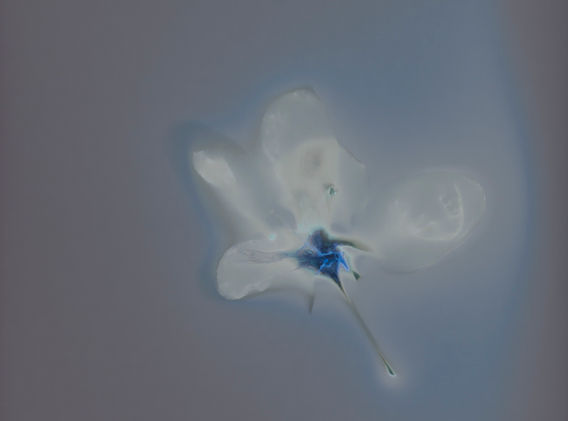Weihs
the thal/annette polaroids
For my project "Das Thal" I followed in the footsteps of Annette von Droste-Hülshoff through the Hönnetal, a good 200 years late. Starting from the Rödinghausen estate, the location of the exhibition, she undertook extensive hikes to the nearby Hönnetal, to Klusenstein Castle and to the Felsenmeer in Hemer during her three-month stay there in the months of September to November 1824. Her impressions and experiences were published anonymously in 1841 in the book Das picturesque and romantic Westphalen. For my series, I picked up this red literary thread and also set out on a hike through this part of my immediate homeland. Specifically, for this series I »dug up« one of my old Polaroid cameras. The minimalist, analogue technology of the camera in combination with old, superimposed and expired film material appears in a perfectly digital world of images as a stable counterpoint. Working with this analogue technique is very experimental. While I set the frame and the time of the shot by pressing the shutter button, the "instant film" then does the rest. Depending on the remaining ability of the integrated chemicals, temperature and time, the image is developed - or not. The result is recordings that acquire a peculiar authenticity through flaws and blurriness. By inverting, i.e. reversing the colors, as we know it from analog black and white and color films, the photographs get their final character.
The result is photographic works that come close to the romantic, mystical and fairytale stories that surround the Hönnetal.
Stories that Annette von Droste Hülshoff certainly got to hear here and that might have inspired new works.
Intentionally imperfect shots that play with the colors and challenge us to see and rediscover the well-known.
»... - then at the estate Rödinghausen - a good distance further on the most majestic rock face in the whole
line of this limestone mountain, which is 200 feet high, and we are thus approaching the Klusenstein. It's a dangerous one
wandering; the valley squeezes ever wilder and gloomier at last into a narrow gorge, the narrow one
Hönne rushes as fast as an arrow down over jagged boulders, bubbling up and blowing waves over the footpath
flinging, until finally the roaring and foaming of a mill rushes towards us from a deep cauldron.
Here the danger has been overcome, a bold, rounded rock face jumps up in front of us, the ring walls tower above it
and ruins of the old castle, from which a newer dwelling-house peeps out like a wealthy tenant of an old knight's splendor. The path leads a little sideways
through the bushes to the entrance of the cave, which yawns at us like a black gate."
das thal/annette photo postcards
For the second series on the "Das Thal" project, I delved deeper into the history of the Hönnetal. The valley was and is not only this romantic valley, which is mentioned in countless travel reports and immortalized on photo postcards. But it is also a place of contrasts. A few kilometers there have the use of the Hönnetal, from the
Stone Age dwelling caves to early industrial iron smelting to limestone quarrying, which is currently the subject of controversial debate, left traces and initiated some far-reaching socio-cultural changes. The valley and the eponymous river Hönne, which flows through the valley, connected people economically and was simultaneous for centuries
separating element between the political-religious dominions. Later, during World War II, forced laborers in the same valley had to dig extensive tunnel systems for the
advance secret Reich armament projects »Schwalbe 2« in the rocks. Some of the traces of this work can still be found today. After the Second World War, the valley served the steelworks in the Ruhr area as a raw material source for lime on weekdays and the workers as a place to relax at weekends. Apart from all (literary) romanticism, the valley was and is also a formative element between the extremes that have always collided there: border and opening, separating and connecting, freedom and imprisonment, romanticism and national madness, ecology and economy.
It is also the special topography and what happened that have influenced the self-image and perspectives of the people who live in and around the valley. With the use of old B/W photo postcards (here AGFA PORTRIGA PK 112, in the classic world format) I build a bridge between (everyday) literature based on Annette's work and my photographic working method. The result is photographs that are very rich in contrast, some of which are strongly reminiscent of typographic works. The hard light-dark contrasts indicate the already described (interest) conflicts to which the valley was exposed in its long history. No romantic, kitschy memories of the kind we're used to seeing on postcards, but rather sharply separated monochrome areas of color that represent a different way of telling the story
enable and - on the back - offer room for interpretation.
flower death
child's play (flower death)
"How are my fingers so green
I tore flowers;
They wanted to bloom for me
And had to die.
They bowed to my face
like pious timid eyelids,
I was thinking, I don't care
And bent her down to me
Rip the dear limbs
In carefree courage.
There flowed her green blood
To my fingers down;
They didn't complain, they didn't cry
They died without a sound
Only her face became dark
like when the sky is grey,
They couldn't spare me
Otherwise they would have done it;
where did i go
In a gloomy delusion?
O foolish children's game,
O innocent bloodshed!
Even if it's a lot like life,
let me close my eyes
'Cause what's done is done
And who can stand for the future?'
Out of:
Levin Schücking, 1879, Collected Writings by Annette Freiin von Droste-Hülshoff - First Part - Lyric Poems, p. 155,
Book printer JG Cotta, Stuttgart



































